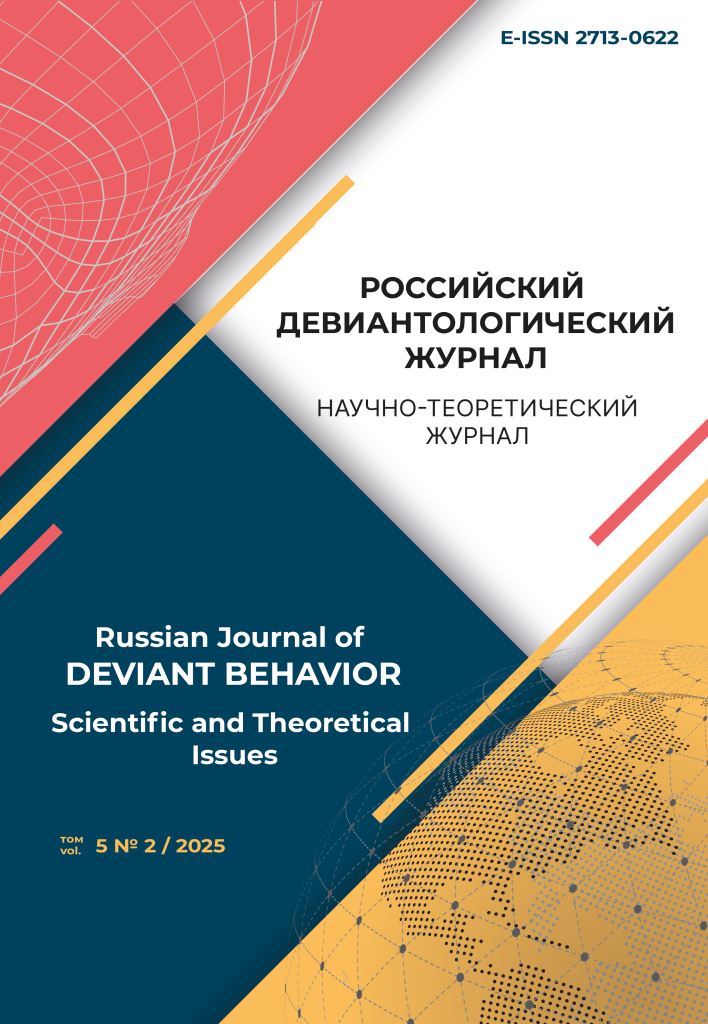Military Educational and Scientific Centre of the Air Force «Professor N.E. Zhukovsky and Y.A. Gagarin Air Force Academy»
Novokuznetsk, Russian Federation
UDC 159.9.075
Introduction. The relevance of the study of the current state of juvenile delinquency is determined by the need to predict the government policy towards adolescents and young people potentially belonging to the group at risk of delinquency. The study of the factors and mechanisms determining the motivation of criminal behaviour of this category of people is possible with the help of special census of convicts and persons in custody, which was conducted in 2022. The aim is to analyze and characterize the current state of the delinquency of minors serving sentences in young offender institutions. Methodology and methods. The article applied general scientific methods of theoretical research aimed at collecting, analyzing, systematizing and summarizing data, in particular, analyzing and interpreting the results of special census of prisoners and detainees (December 2022) and scientific sources directly revealing the subject of the study. The research methodology is based on the socio-demographic and criminal law characteristics of juvenile offenders. The results of the study show that male representatives predominate among juvenile offenders. Adolescents and young men commit delinquent acts most often at the age of 16-17, which is due to the active stage of experiencing crisis of adolescence. The vast majority of people serving sentences in young offender institutions have basic general education and are raised in dysfunctional families or do not have a family at all. The dominant category is aggravated and especially aggravated crimes committed by young people intentionally and consciously. Almost a third of juvenile delinquents are serving sentences for violent crimes committed by a group of people. At the same time, the largest group of juvenile offenders has short terms of imprisonment, which reflects the leading trend of humanizing criminal punishment for minors. The results obtained make it possible to carry out the work on the prediction and prevention of illegal actions among young people, as well as to propose optimal options for psychological and pedagogical impact on criminogenic determinants that negatively affect the formation of the personality of minors.
juvenile delinquents, criminal punishment, statistics, socio-demographic characteristics, criminal law characteristics
1. Abramova, N. G. (2022). K voprosu o lichnosti nesovershennoletnego osuzhdennogo. Yuridicheskij vestnik Dagestanskogo gosudarstvennogo universiteta, 1 (41), 116–120. https://doi.org/10.21779/2224-0241-2022-41-1-116-120
2. Agafonov, Yu. A., Il'yashenko, A. N. (2007). Faktory semejnogo neblagopoluchiya v genezise prestupnogo povedeniya nesovershennoletnih. Obshchestvo i pravo, 3 (17), 11–17.
3. Antonyan, Yu. M. (1992). Prestupnost' sredi zhenshchin: monografiya. Moskow: Rossijskoe pravo.
4. Antonyan, Yu. M. (2017). Lichnost' prestupnika i profilaktika prestuplenij. Moskow: Izdatel'stvo "Prospekt".
5. Arhipova M. V., Red'kina E. A. (2023). Osobennosti sovremennoj prestupnosti nesovershennoletnih. Vestnik Rossijskogo universiteta kooperacii, 3 (53), 98–106.
6. Afonchenko, T. P. i dr. (2020). Gendernaya kriminologiya: ponyatie, struktura, soderzhanie: monografiya. Minsk: Izdatel'stvo «Ekoperspektiva».
7. Gelyahova, L. A. (2020). Rol' obrazovatel'nyh uchrezhdenij v protivodejstvii podrostkovoj prestupnosti. Probely v rossijskom zakonodatel'stve, 13 (4), 379–382.
8. Gernet, M. N. (2020). Instinkt zaklyuchennogo. Ocherki tyuremnoj psihologii. Moskow: Izdatel'stvo «Eksmo».
9. Gilinskij, Ya. I. (2024). Kriminologiya i devintologiya postmoderna. Saint Petersburg: Izdatel'stvo «Aletejya».
10. Gotchina, L. V. (2021) Prestupnost' nesovershennoletnih i molodezhi: sostoyanie i perspektivy. Rossijskij deviantologicheskij zhurnal, 1 (2), 304–313. https://doi.org/10.35750/2713-0622- 2021-2-304-313
11. Demidova-Petrova, E. V., Rogova, E. V. (2024). Prestupnost' nesovershennoletnih v usloviyah sovre¬mennyh vyzovov. Sibirskij yuridicheskij vestnik, 2 (105), 70–74. https://doi.org/10.26516/2071- 8136.2024.2.70
12. Zhaasynbek kyzy, A. (2021). Podrostok i prestuplenie. Izvestiya vuzov Kyrgyzstana, 5, 180–183. https://doi.org/10.26104/IVK.2019.45.557
13. Zajko, T. M. (2017). Mery bor'by s prestupnost'yu nesovershennoletnih i molodezhi: pravovoj i psihologo-kriminologicheskij aspekty: monografiya. Tambov: OOO "Konsaltingovaya kompaniya Yukom".
14. Kolesnikov, R. V. (2021). Faktory, determiniruyushchie gruppovye prestupleniya nesovershennoletnih. Vestnik Voronezhskogo instituta MVD Rossii, 4, 201–208.
15. Kornakova, S. V., Koryagina, S. A. (2023). Sovremennye aspekty nasil'stvennoj prestupnosti nesovershennoletnih. Lex russica, 7 (76), 76–86. https://doi.org/10.17803/17295920.2023.200.7.076-086
16. Mel'nikova, O. V. i dr. (2021). Prestupnost' nesovershennoletnih: monografiya. Pskov: Pskovskij filial Akademii FSIN Rossii.
17. Rogacheva, E. Yu. (2024). "Psiholog-prorok" Grenvill Stenli Holl. Vektory psihologo-pedagogicheskih issledovanij, 1 (02), 110–117.
18. Samofalov, S. P., Demidova, D. R. (2024). Motivy i celi soversheniya prestuplenij nesovershennoletnimi. Vestnik Permskogo instituta Federal'noj sluzhby ispolneniya nakazanij, 4 (55), 104–111.
19. Seliverstov, V. I., Kirillova, T. V., Kunc, E. V. (2024). Harakteristika osuzhdennyh, otbyvayushchih nakazanie v vospitatel'nyh koloniyah (po materialam special'noj perepisi osuzhdennyh i lic, soderzhashchihsya pod strazhej, dekabr' 2022 goda): monografiya. Moskow: Izdatel'stvo «Prospekt».
20. Faskhutdinov, R. F. (2018). Nekotorye aspekty psihicheskogo nasiliya v seti internet kak odnogo iz sposobov soversheniya prestupleniya protiv nesovershennoletnih. Evrazijskij yuridicheskij zhurnal, 10 (125), 284–285.














